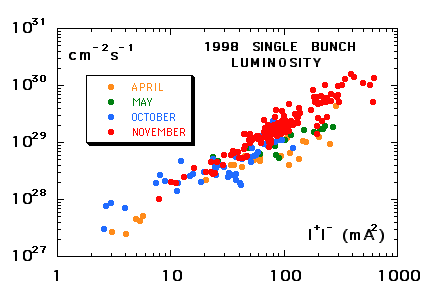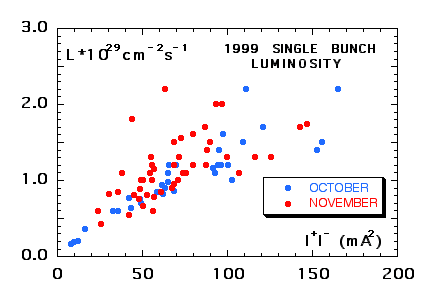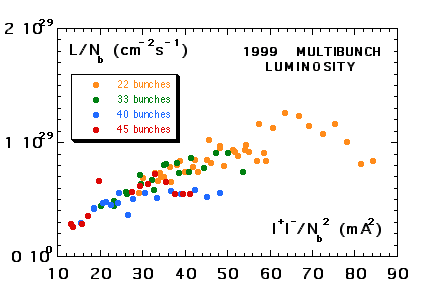
Single bunch luminosity measurements with the "DAY-ONE" interaction regions in the single bunch operation mode
DAFNE COMMISSIONING UPDATE (December 22, 2000)
The DAFNE collider was operated from mid-September until 4 December. During running, machine studies were interspersed with KLOE data taking. The peak luminosity achieved in KLOE Interaction Region was 1.8E31 cm-2 s-1. The integrated luminosity delivered to KLOE detector during the year 2000 was 28 pb-1 with a peak recorded daily luminosity of 830 nb-1. Operation was transferred to DEAR run from 4 December till 21 December. This run was dedicated to background studies and search for suitable working point.
DAFNE COMMISSIONING UPDATE (June 26, 2000)
In the following the main results of the last two weeks of machine development shifts (June 12 to June 26) are summarized:
1) Vacuum:
The vacuum conditions are steadily improving due to beam conditioning. The amount of radiation delivered to the vacuum chambers corresponds now to an integrated current of 96 Amperehours (Ah) to the electron ring and 69 Ah to the positron one since the winter shutdown. The improved vacuum conditions in the electron ring are beneficial to the problems connected with ion trapping, and the gap in the electron beam necessary to avoid this effect is now strongly reduced; typical equally spaced fillings of 31-33 bunches out of 40 are now routinely achieved.
2) Single bunch luminosity:
Fine tuning of single bunch beam-beam parameters have further improved single bunch luminosity. The best results are in the range 5-6x1029 cm-2s-1.
3) Multibunch luminosity:
Two beams operation in multibunch mode have been the main item of these machine development shifts. Several patterns of bunches on different operating points have been attempted, and stable operating conditions have been achieved with stored currents up to 0.4 A per beam. The best luminosity obtained is 1031 cm-2s-1(*), corresponding to a single bunch luminosity of 3.5x1029 cm-2s-1 times the number of bunches. The luminosity lifetime is of the order of half hour.
4) Backgrounds in the experiment
The background rate in KLOE has been also tested. Preliminary results indicate an increase of the background levels with respect to those measured during the physics runs in December 1999. The reasons for the higher background need further investigation; possible sources are the different orbit conditions and/or the higher specific luminosity.
(*) The luminosity in multibunch operation could only be measured by the KLOE luminosity monitor. The efficient and continuous collaboration of the KLOE group to the efforts of the Accelerator Division is gratefully acknowledged.
DAFNE COMMISSIONING UPDATE (June 5, 2000)
Two weeks of machine development have been done from May 22 to June 4. A brief summary of the results follows.
1) Vacuum conditioning with beam:
A fine tune-up of the longitudinal feedback and of the injection procedure in the multibunch mode allowed to exceed the value of 1 A of stored current in both the positron and electron rings. This high current scenario is strongly improving the efficiency of vacuum conditioning with beam after the failure experienced at the end of last April.
2) Single bunch luminosity:
The investigation of different working points continued. As far as dynamic aperture is concerned, the fast transient digitizer system has been put in operation. Measurements of the tune shift with amplitude are now possible and a more efficient optimization of the dynamic aperture can be performed. Coupling has been further decreased. Emittance ratios close to 0.002 have been obtained in both the beams, indicating rms vertical dimension at IP as low as 10 microns.
3) Multibunch luminosity:
Few runs in the multibunch mode have been also tried. Luminosities in the range of 3-4x1030 cm-2s-1 with small values of stored current (120+120 mA) in a small number of bunches (15+15) have been obtained.
DAFNE COMMISSIONING UPDATE (MAY 15, 2000)
During the third period of DAFNE commissioning (see schedule) special care has been taken in minimizing the coupling of the two rings, and it apperas clearly at this stage that beam blow-up is strongly reduced when the rings are well decoupled. Vertical to horizontal emittance ratios as low as 3x10-3 have been estimated from beam size measurements at the synchrotron radiation monitor and vertical scans of one beam through the other one at the KLOE crossing point.
Single bunch crossings were also attempted with different tunes in the two rings, with the aim of reaching the minimum blow-up associated with the best obtainable lifetime. The best result was within 3.5 and 4x1029cm-2s-1 with lifetimes of 2x103 s.
Multibunch interactions were also tried with a number of 6 bunches against 6, limited by vacuum conditions only. KLOE made a run of about one hour, measuring a peak luminosity of ~2.2x1030cm-2s-1 with acceptable backgrounds. The luminosity measured by KLOE was in agreement with the results of DAFNE's luminosity monitor.
Vacuum conditions are also improving since the vacuum breakdown at the end of the last period of shifts. Before the accident 15.1 Ah have been delivered to the electron ring, 9.5 Ah to the positron one. In this last period the electron ring received 15.5 Ah, the positron one 16.6 Ah.
DAFNE COMMISSIONING UPDATE (APRIL 27, 2000)
The second period of DAFNE commissioning (see schedule) was mainly dedicated at tuning the two rings on a new working point (Qx=5.10, Qy=5.14) with KLOE field at 5.2 kG.
Collisions were also tried at the end of the shifts, and we observed much less beam blow-up with respect to the previous working points, even though the KLOE interaction region was not perfectly tuned.
The machine development period was stopped 2 days in advance because of a vacuum accident in the main rings. The vacuum loss has been fixed and commissioning will resume according to the schedule.
DAFNE COMMISSIONING UPDATE (APRIL 4, 2000)
During the winter shutdown, apart from the ordinary maintenance, 3 major tasks have been accomplished:
- Installation of the new control system
- Installation of new HOM damped injection kickers
- Realignment of KLOE low-beta triplets which were found misplaced by ~ 1 mm
The first two weeks of DAFNE start-up were spent mainly on optics tune-up and vacuum conditioning with beam.
From the optics point of view, we have made the 2 rings almost identical and achieved a global decoupling of 0.7%, by readjusting the closed orbits and by lowering the KLOE solenoidal field from 6 to ~ 5.2 kGauss. Emittance has also been set to the nominal value of 1 mm-mrad.
Some time has been allocated to prove different schemes of sextupoles chromatic corrections intended to improve dynamic aperture and reduce tune-shift with amplitude.
The last few days have been spent to test, on this improved optics situation, single-bunch luminosity. A luminosity equal to 90% of the expected one has been achieved up to a bunch current of 8-9 mA in each beam. By increasing the bunch current beam blow-up has been observed with consequent luminosity saturation. The luminosity tests have been carried out on the old tune (5.17, 5.21) and the beam blow-up current value seems to be in good agreement with simulations.
Our plan is to continue the work on single bunch luminosity and to explore, next week, different tune working points.
SUMMARY OF DAFNE LUMINOSITY PERFORMANCE UP TO DECEMBER 1999
The first phase of DAFNE commissioning without experimental detectors was concluded at the end of 1998. Both interaction regions were realized with 7 seven quadrupoles providing low vertical beta (4.5 cm) at the crossing points (this magnetic structure is called "DAY-ONE"). The luminosity measurements were performed mainly in a single interaction region, with the beams separated in the vertical plane in the other one and a single bunch in each beam. A collection of luminosity measurements is shown in the first figure: the luminosity was continuously improved, reaching more than 1030cm-2s-1, with stored currents up to more than 20 mA in each beam, to be compared with the design values of 4*1030cm-2s-1 and 44 mA respectively . A short period of commissioning has been also dedicated to multibunch operation, reaching 1031cm-2s-1 with 13 bunches in each beam.

Single bunch luminosity measurements with the "DAY-ONE" interaction regions in the single bunch operation mode
After the installation of the KLOE detector, including a superconducting solenoid with a longitudinal field of 0.6 T (the field integral is 2.4 Tm) and permanent magnet quadrupole triplets inside, the luminosity performance of the collider was rather strongly reduced, although the beam coupling introduced by the solenoid has been successfully corrected down to the design value of 1%. The second plot collects the best results obtained in the single bunch mode in fall 1999, with the maximum luminosity around 2*1029cm-2s-1and currents below 15 mA per bunch. A slight saturation of the luminosity versus the product of electron and positron currents can be observed, corresponding to a vertical blow-up of the beams above 10 mA per bunch. The reason for the lower luminosity with respect to the operation without KLOE is still under investigation.

Single bunch luminosity measurements with the KLOE interaction region in the single bunch operation mode
In December 1999 about four weeks have been dedicated to continuous colliding beam operation for KLOE experimental runs in multibunch mode with initial run luminosity ranging between 3 and 5*1030cm-2s-1. Several configurations of bunch patterns and injection procedures have been realized with the aim of optimizing the average luminosity. The final result was an integrated luminosity of more than 100 nb-1 per day. In order to directly compare the results with those obtained in the single bunch mode, the third plot shows the luminosity divided by the number of bunches in each beam versus the product of the total electron and positron currents divided by the number of bunches squared. The measurements are taken during the data collection. The values are about a factor two less than those obtained in the single bunch mode, mostly because of the need to keep the background rate in the detector sufficiently low.

Luminosity measurements in multibunch mode during the KLOE experimental runs. Luminosity and currents are normalized to the number of stored bunches in order to be directly compared to those obtained in the single bunch mode.